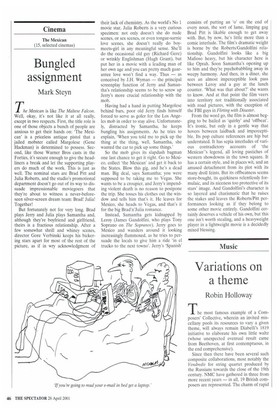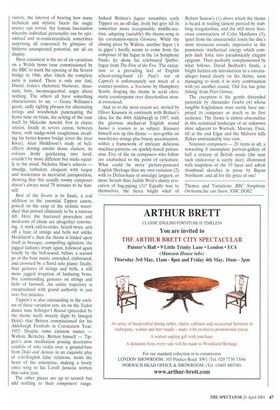Variations on a theme
Robin Holloway
The most famous example of a Composers' Collective, wherein an invited miscellany pools its resources to vary a given theme, will always remain Diabelli's 1819 initiative to elaborate his own little waltz (whose unexpected eventual result came from Beethoven, at first contemptuous, in the end comprehensive).
Since then there have been several such composite collaborations, most notably the Vendredis for string quartet produced by the Russians towards the close of the 19th century. NMC have gathered in three from more recent years — in all, 19 British composers are represented. The charm of rapid variety. the interest of hearing how many technical and stylistic facets the single source can reveal, the human fascination whereby individual personality can be epitomised and re-contexturalised, sometimes surprising all concerned by glimpses of hitherto unsuspected potential, are all on display.
Most consistent is the set of six variations on a Welsh hymn tune commissioned by the BBC to mark the opening of the Severn bridge in 1966, after which the complete suite is named. There is only one dud, Daniel Jones's rhetorical blusterer, dissonant, bitty, inconsequential, angry about nothing. The others all have something characteristic to say — Grace Williams's gaunt, sadly sighing phrases for alternating strings and woodwinds punctuating the hymn tune on brass, the setting of the tune itself by Malcolm Arnold, first in chaste unison, finally in severe canon, between these, with nudge-wink naughtiness recalling his better-known bridge (over the river Kwai). Alan Hoddinott's study of belleffects shining amidst dense clusters, its colours dusky quickening into lurid, couldn't be more different but sticks equally in the mind. Nicholas Maw's scherzo — smudgy, turbulent, eloquent with turgor and tenderness in mercurial juxtaposition, showing that this usually roomy composer doesn't always need 70 minutes to be himself.
Best of the Severn is its finale, a real addition to the essential Tippett canon, poised on the cusp of the stylistic watershed that proved ultimately to be a ruinous rift. Here the fractured procedure and mod-cons of idiom are altogether convincing. A stark call-to-order, heard twice, sets off a haze of strings and bells not unlike Hoddinott's, then the theme is folded upon itself in brusque, compelling agitation; the jagged fanfares irrupt again, followed again briefly by the bell-sound, before a second go at the busy music, extended, elaborated, and crowned by a florid solo piano; finally, four gestures of strings and bells, a still more jagged irruption of fanfaring brass, five commanding gestures on strings and bells of farewell. An entire trajectory is encapsulated with grand authority in just over five minutes.
Tippett's is also outstanding in the earliest of these variation sets, six on the Tudor dance tune Sellenger's Round (preceded by the theme itself, sweetly dight by Imogen Hoist) that Britten commissioned for his Aldeburgh Festivals in Coronation Year, 1953. Despite some eminent names — Walton. Berkeley, Britten himself — Tippett's slow meditation poising decorative tendrils of solo violin over a ground-bass from Dido and Aeneas in an exquisite play of echt-English false relations, steals the heart of the enterprise, making a lovely extra wing to his Corelli fantazia written that same year.
The other pieces are up to scratch but add nothing to their composers' range.
Indeed Britten's fugato resembles early Tippett on an off-day, lively but grey till its somewhat more recognisable middle-section, adapting (suitably) the theme-song in his coronation-opera Gloriana. While the closing piece by Walton, another fugue Ca la gigue') hardly seems to come from the composer of the fugue in the 1st Symphony finale, let alone his celebrated Spitfirefugue from The First of the Few. The exception to a prevailing feel of English school-string-band (St Paul's out of Captiol) is unfortunately not much of a counter-positive, a Nocturne by Humphrey Searle, draping the theme in acrid chromatic counterpoint over directionless atonal tremolandi.
And so to the most recent set, invited by Oliver Knussen in continuity with Britten's idea, for the 40th Aldeburgh in 1987, with the glorious mediaeval English round Sumer is icumen in as subject. Knussen himself sets up this theme — neo-gothic on nouvibrato strings plus brassy accentuation, within a framework of intricate delicious machine-patterns on sparkly-tuned percussion. Five of the six composers who follow are unabashed to the point of caricature. What could be more picture-postcard English Heritage than my own variation (2) with its Delius-haze of nostalgic languor, or more Scotch than Judith Weir's dainty evocation of bag-piping (3)? Equally true to themselves, the fierce bright whirl of Robert Saxton's (1) above which the theme is heard in wailing lament pierced by stabbing irregularities, and the still more ferocious construction of Colin Matthews (5), apart from the unsuccessful Jones the disc's most strenuous sounds, impressive in the passionate intellectual energy which compels dark force into paradoxically elegant epigram. Then perfectly complemented by what follows, David Bedford's finale, a bright fanfare-ish introduction to a toccataallegro based clearly on the theme, soon managing to work it in witty combination with yet another round, 'Old Joe has gone fishing' from Peter Grimes.
The exception is the gentle distended pastorale by Alexander Goehr (4) whose tangible Englishness must surely have surprised its composer as much as its first audience. The theme is almost absconditus in this sensitised landscape of an unknown shire adjacent to Warlock, Moeran, Finzi, till at the end Elgar and the Malvern hills flicker unmistakably into view.
Nineteen composers — 20 items in all; a rewarding if incomplete portrait-gallery of half a century of British music (the next such endeavour is surely due): illustrated with snapshots of the 19 faces and adroit thumbnail sketches in prose by Bayan Northcott; and all for the price of one!
Themes and Variations: BBC Symphony Orchestra/Jac van Steen; NMC D062.



































































 Previous page
Previous page